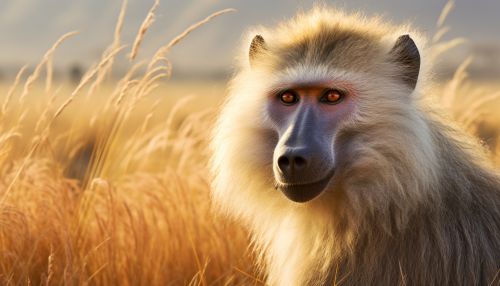Baboon
Taxonomy and Evolution
Baboons belong to the genus Papio, one of the 23 genera of Old World monkeys. The genus is divided into six species, each with distinct physical and behavioral characteristics. The six species are the Hamadryas, the Olive, the Yellow, the Chacma, the Guinea, and the Kinda.
The evolution of baboons has been studied extensively, and it is believed that they diverged from their common ancestor with humans approximately 30 million years ago. Fossil records indicate that the genus Papio first appeared in the Miocene epoch, around 5.5 million years ago.


Physical Characteristics
Baboons are some of the world's largest monkeys, with males of the larger species reaching up to 120 cm in body length and weighing up to 40 kg. They have a distinctive appearance, with a dog-like snout in contrast to the flat-faced profile of other primates. Their fur color varies from dark brown to light grey, and their faces, rumps, and some parts of their body are hairless.
One of the most notable physical characteristics of baboons is their ischial callosities, or sitting pads, which are tough, hairless pads of skin on their buttocks. These adaptations allow baboons to sit comfortably on rocky surfaces for extended periods.
Behavior and Ecology
Baboons are highly social animals, living in troops that can number up to 150 individuals. These troops have a complex hierarchical structure, with dominant males and females leading the group. Social interactions, including grooming and play, are crucial for maintaining social bonds within the troop.
Baboons are diurnal, spending their days foraging for a diverse diet that includes fruits, grasses, seeds, and invertebrates. They are also known to hunt small mammals, birds, and even fish, demonstrating their adaptability and opportunistic feeding behavior.
Baboons have a range of vocal and visual signals that they use to communicate with each other. These include alarm calls to warn of predators, submissive gestures to signal non-aggression, and displays of dominance to assert status within the troop.
Reproduction
Baboon females reach sexual maturity at around six years of age, while males mature a few years later. Females give birth to a single offspring after a gestation period of around six months. The young baboon is cared for by its mother and other females in the troop, a behavior known as alloparenting.
Baboons have a polygynous mating system, with dominant males having access to multiple females. However, females often exhibit mate choice, and may mate with lower-ranking males in the absence of the dominant male.
Conservation
While baboons are not currently considered endangered, their populations in certain areas are under threat due to habitat loss and hunting. Conservation efforts are focused on preserving their natural habitats and implementing measures to reduce human-baboon conflict.
